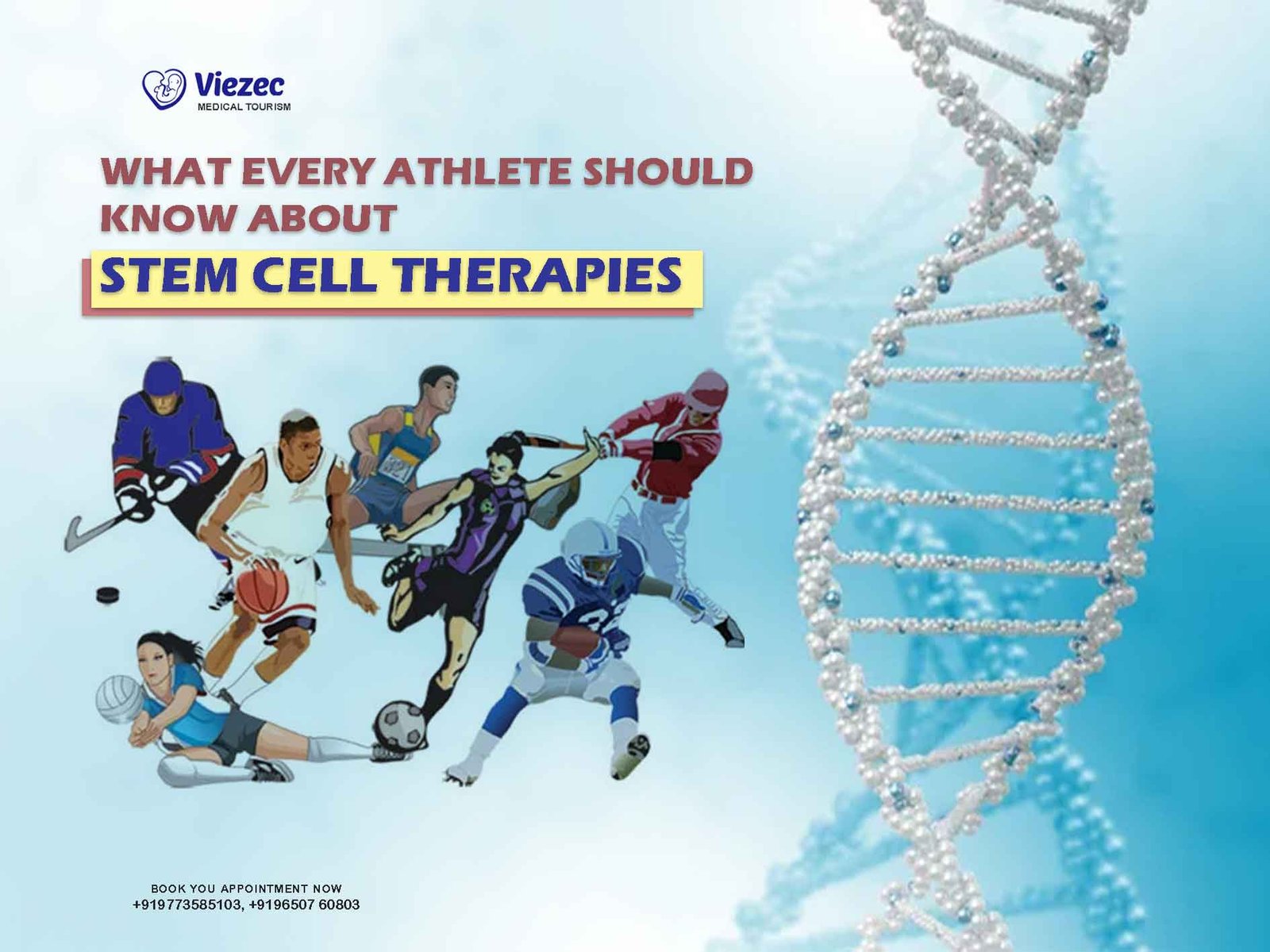Stem cell therapy has emerged as a promising treatment option for athletes seeking to recover from injuries and enhance their performance. Stem cells have the remarkable ability to regenerate and repair damaged tissues, offering athletes a natural and potentially effective way to heal and optimize their physical condition. We’ll explore the essentials of stem cell therapy for athletes, exploring its benefits, applications, limitations, and future prospects.
Understanding Stem Cells
What are Stem Cells?
Stem cells are unique cells with the capacity to develop into various specialized cell types in the body. They possess two key characteristics: self-renewal (the ability to replicate themselves) and pluripotency (the ability to differentiate into different cell types). Stem cells are found in various tissues and organs throughout the body, including bone marrow, adipose tissue, and umbilical cord blood.
Types of Stem Cells
There are several types of stem cells used in therapy, each with its own advantages and potential applications:
- Embryonic Stem Cells (ESCs): Derived from early-stage embryos, these cells have the highest potential for differentiation but also raise ethical concerns due to their origin.
- Adult Stem Cells: Also known as somatic or tissue-specific stem cells, these are found in mature tissues and play a role in tissue repair and regeneration.
- Induced Pluripotent Stem Cells (iPSCs): These are adult cells that have been reprogrammed to behave like embryonic stem cells, offering the advantages of pluripotency without the ethical concerns associated with ESCs.
Applications of Stem Cell Therapy in Sports Medicine
Injury Recovery
Stem cell therapy holds immense promise for athletes recovering from injuries, particularly those involving musculoskeletal tissues such as ligaments, tendons, and cartilage. By delivering stem cells directly to the site of injury, therapy aims to stimulate tissue regeneration and accelerate the healing process. Common injuries treated with stem cell therapy include:
- Tendonitis
- Ligament Sprains
- Muscle Tears
- Cartilage Damage
Joint Health and Osteoarthritis
For athletes grappling with joint pain and osteoarthritis, stem cell therapy offers a potential alternative to invasive surgeries such as joint replacements. By injecting stem cells into damaged joints, therapy aims to reduce inflammation, promote cartilage regeneration, and improve overall joint function, thereby alleviating pain and restoring mobility.
Performance Enhancement
Beyond injury recovery, some athletes explore stem cell therapy as a means of enhancing performance and optimizing physical condition. While research in this area is still in its infancy, proponents believe that stem cells may contribute to muscle repair, regeneration, and growth, potentially enhancing strength, endurance, and recovery.
Process of Stem Cell Therapy
Harvesting Stem Cells
The first step in stem cell therapy involves harvesting stem cells from the patient’s own body or from a suitable donor. Common sources of stem cells include bone marrow, adipose tissue (fat), and umbilical cord blood. The choice of source depends on various factors such as the type of injury being treated, the patient’s medical history, and the physician’s recommendation.
Isolation and Processing
Once harvested, stem cells undergo isolation and processing to concentrate them into a usable form. This may involve centrifugation, filtration, or other specialized techniques to remove impurities and maximize the number of viable stem cells.
Administration
After processing, the concentrated stem cells are administered to the patient via injection or infusion. The delivery method depends on the specific injury or condition being treated and may involve direct injection into the affected tissue or systemic administration via intravenous infusion.
Follow-Up and Rehabilitation
Following stem cell therapy, athletes typically undergo a period of rehabilitation to optimize the outcomes of treatment. This may include physical therapy, rest, and activity modification to support the healing process and prevent re-injury. Regular follow-up appointments with the treating physician are essential to monitor progress and adjust the treatment plan as needed.
Benefits of Stem Cell Therapy for Athletes
Non-Surgical Approach
One of the key advantages of stem cell therapy is its minimally invasive nature. Unlike traditional surgical interventions, which carry risks such as infection, scarring, and prolonged recovery times, stem cell therapy offers a non-surgical alternative that may reduce downtime and enable athletes to return to training and competition more quickly.
Tissue Regeneration
Stem cells have the remarkable ability to regenerate and repair damaged tissues, making them an attractive option for athletes seeking to recover from injuries and optimize their physical performance. By harnessing the body’s natural healing processes, stem cell therapy offers the potential to promote tissue regeneration and restore function in injured areas.
Personalized Treatment
Stem cell therapy can be personalized to suit the individual needs of each athlete, taking into account factors such as the type and severity of the injury, the athlete’s medical history, and their performance goals. This personalized approach allows for targeted treatment that addresses the root cause of the problem and maximizes the likelihood of a successful outcome.
Regulatory Oversight
Stem cell therapy is a rapidly evolving field with ongoing research and development, but it also faces regulatory challenges and concerns. The regulatory landscape governing stem cell therapies varies from country to country, with differences in approval processes, safety standards, and ethical considerations. Athletes considering stem cell therapy should seek treatment from reputable providers who adhere to established guidelines and standards of care.
Efficacy and Long-Term Outcomes
While stem cell therapy shows promise as a treatment for sports injuries, its efficacy and long-term outcomes are still being studied. Clinical research is ongoing to evaluate the safety and effectiveness of stem cell therapies in athletes, including randomized controlled trials and long-term follow-up studies. Athletes considering stem cell therapy should weigh the potential benefits against the current evidence and discuss their options with a qualified healthcare provider.
Cost and Accessibility
Stem cell therapy can be costly, and insurance coverage may vary depending on the type of treatment and the patient’s insurance plan. Additionally, access to stem cell therapy may be limited in some regions or healthcare systems, posing challenges for athletes seeking treatment. Athletes should consider the financial implications of stem cell therapy and explore alternative treatment options if cost is a concern.
Advancements in Technology
Advancements in stem cell technology hold the potential to revolutionize sports medicine and enhance the treatment options available to athletes. Researchers are exploring novel techniques for stem cell isolation, culture, and delivery, as well as innovative applications such as tissue engineering and gene editing. These advancements may pave the way for more effective and personalized therapies tailored to the unique needs of athletes.
Regulatory Frameworks
As the field of stem cell therapy continues to evolve, regulatory frameworks will play a crucial role in ensuring patient safety and promoting responsible innovation. Regulatory agencies around the world are actively engaged in reviewing and updating guidelines for stem cell therapies, with a focus on balancing innovation with safety and ethical considerations. Athletes, healthcare providers, and policymakers alike must stay informed about regulatory developments and adhere to established standards of practice.
Recover from Injuries
Stem cell therapy holds tremendous potential for athletes seeking to recover from injuries, enhance performance, and optimize their physical condition. By harnessing the regenerative properties of stem cells, therapy offers a promising alternative to traditional treatments such as surgery and medication. While research in this field is ongoing and regulatory challenges remain, stem cell therapy represents a cutting-edge approach to sports medicine that may benefit athletes of all levels. As the science continues to advance, athletes and healthcare providers must work together to explore the potential of stem cell therapy and ensure its safe and responsible integration into sports medicine practice.









